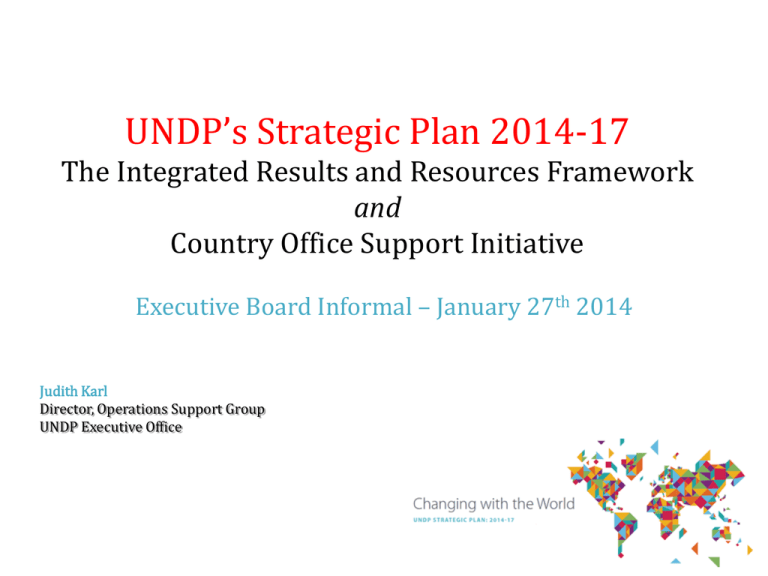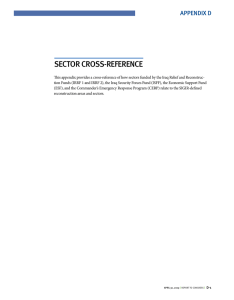
UNDP’s Strategic Plan 2014-17
The Integrated Results and Resources Framework
and
Country Office Support Initiative
Executive Board Informal – January 27th 2014
Judith Karl
Director, Operations Support Group
UNDP Executive Office
Contents
Transition to the new Strategic Plan
• Country-level self-assessment of alignment to the
new SP
• Linking results and resources to the new IRRF’s
outcomes and outputs
• Setting baselines and targets
• Country Office Support Initiative (COSI)
• Next steps
Programme Transition to the new
Strategic Plan:
Key Executive Board Decisions:
UNDP Strategic Plan: 2014-2017
Changing with the World
UNDP will populate the IRRF with
indicators, baselines, milestones and
targets in time for the June 2014 Board
Setting Baselines and Targets
ROAR 2013
ABP and IWPs 2014
Linking results and resources
CO Self- Assessment of SP Alignment
Country Office Self- Assessment of Alignment
Alignment issue
Targeting
Change at scake
Voice and participation
Building resilience
SS&TC
Readiness for change
Capacities to implement SP
RBA
RBAP
RBAS
RBEC
Challenges:
• Target female-headed households; and support LIC national
systems to disaggregate data for better targeting of extreme poor
• Better inclusion of women and youth in economic decisionmaking processes
• Systematic use of SS&T cooperation across the portfolio
• Increase awareness/knowledge of staff in new areas of UNDP
support (ex: extractive industries, sustainable economies)
• Increase CO capacities for data collection & analysis
RBLAC
UNDP
Linking Results with Resources
SP Outcome 1: Inclusive & sustainable
growth & development
CP Outcome 1
Country
Programme
•
•
•
•
Output 1.1
……..
Output 1.5
Project 1-Output 1
Project 1-Output 2
Project 2-Output 1
…
SP Outcome 2: Stronger Democratic
Governance to meet citizen expectations
CP Outcome 2
• Project 1-Output 1
• Project 2-Output 1
• …
Output 2.1
…..
Output 2.5
…
Regional
Programme
RP Outcome 1
•
•
•
•
Project 1-Output 1
Project 1-Output 2
Project 2-Output 1
….
…
Global
Programme
Organizational
Effectiveness and
Efficiency
Output 3.1
Output 3.2
…..
Output 3.6
…
GP Outcome 1
• Project 1-Outout 1
• Project 1-Output 2
• ……
Management
•
•
•
•
……
SP Outcome 3. Institutions enabled to
deliver universal access to basic services
Project 1-Output 1
Project 2 –output 1
Project 2- Output 2
……..
Outcome 7: Thought leadership
Output 7.1
……..
Output 7.7
Organizational Effectiveness and Efficiency
Result Area 1
……..
Result Area 9
Linking Results and Resources (1)
• The linking exercise enables UNDP to see our current “footprint” across the
priorities of the SP.
• A Quality Assurance process is being conducted to analyze the footprint,
ensure it captures a robust picture of the organisation’s expected results,
compare it with resource projections presented in the September 2013 IRRF
(based on 2012 expenditure), and understand sparsely linked outputs
• This will help UNDP inter alia to identify where we need to focus or
increase advisory support services, invest in knowledge management,
and/or address duplications and redundancies in the IRRF.
Linking Results and Resources (2)
• Initial findings from the exercise show that linking results and resources is not an
exact science – choices are being made about which output and outcome to link to across an integrated, multi-dimensional framework.
• The multi-dimensionality of the new plan means that there will be trade-offs in
terms of outcome/output choices. Understanding how these trade-offs affect the
emerging results to resources picture will be critical to decision making.
• Through the QA process UNDP is exploring these issues alongside the alignment selfassessment, including: analyzing the “unlinked” results, and differences between
resource projections as per the approved IRRF against current resources linked.
• Current emerging trends show that some rebalancing may be required between
output choices in order to better reflect the intended results (e.g. a concentration on
Output 1.1. is being reviewed to see whether some results actually relate more to
early recovery settings, Outcome 6, and others).
Baseline and Target Setting: towards a Populated IRRF
Translate IRRF
indicators into data
specifications
Develop
methodological
notes for indicators
System
development
Training, technical support, data analysis and quality assurance
Link
country
results with
the SP
results
Identify
indicators
to report
on the
results
Populated
IRRF
For EB June
Session
Setting
Indicator
baselines
and targets
Roles and responsibilities are being defined across Country Offices, Regional Bureaus and Service Centers, Bureaus and
HQ units to ensure that IRRF data collection, analysis, support and QA is institutionalized but also grounded in the SP’s
aim to deliver higher quality programmes through better project planning, design, monitoring and evaluation,
underpinned by stronger results-based management (RBM).
IRRF Baseline and Targeting Setting
(Issues and Challenges)
• Indicator selection: COs may find the output relevant but not the indicator; or
find 2 sets of indicators relevant (in different outputs), and that may confuse
our results picture.
• Indicator relevance: we expect the baseline and targeting setting process to
identify some indicators that are not relevant to COs, so adapting indicators
will be an on-going process.
• Data disaggregation: the IRRF specifies many levels of data disaggregation.
Corporate systems will require sex disaggregation and will leave other levels
(e.g. geographic and population groups) to country-by-country availability.
• Setting baselines: to the extent possible, baselines will be set according to
results to date (as of December 31st 2013).
• Setting targets: targets will be aggregated from COs according to their
programme cycles, many of which are not on the same timeline as the SP
• Rationalizing existing CPD indicators: work will continue with COs to simplify
country programme document indicators, to adjust to the new SP IRRF and to
simplify those CPD indicators that are not being actively used
Evidence base
UNDP reporting will be based on evidence from the SP IRRF results architecture +
ROAR: a combination of independent and self-reported data
Monitoring:
• There will more robust and time sensitive data collection for performance
management and decision-making
• Based on updated qualitative and quantitative data sources and analysis using
more robust and innovative methodologies
• Aggregatable results for learning/knowledge management and results reporting
• Challenge of obtaining robust data from independent sources will continue at
country level and should see incremental improvements
Decentralized and independent evaluations
• Will provide an independent view of UNDP’s relevance and sustainability of results
• Promotes lessons learning/sharing
Peer Review Group Feedback (5th Round)
Common issues and feedback:
• Data disaggregation is possible on a country by country basis; but at a corporate
level only sex disaggregation has been made mandatory by some peers
complemented by gender sensitive indicators
• Targeting: for outcome indicators peers generally agreed that it may only be
possible to set direction of travel rather than specific targets and/or to distinguish
between “Progress on” versus “Progress Towards” targets; all targets may need
adjustment when circumstances shift significantly.
• Aggregation: Peers recommended a minimum threshold for indicator monitoring
to make aggregation meaningful (e.g. 10 countries/projects at minimum must
monitor the indicator for aggregation to be meaningful)
• Balancing “organizational” and country specific indicators: peers recommended
that key corporate indicators and country/project specific indicators are needed;
and programmes act as the “bridge” between corporate and project level data
• Organizational benchmarks or standards for staffing and resourcing M&E
capacity: no generic standard – references to improved RBM guidelines, training
and “sufficient” specialist staff in HQ as well as a separate professional,
evaluation function; one has invested in statistics/results staff in larger COs.
COSI: Country Office Support Initiative
• The SP has a commitment to: establish a sustainable RBM support mechanism to
work with country offices over the next two years. Regional Bureaux will play a critical
role in overseeing all programme delivery and performance.
• Internal Regional Roadmaps to Strengthen RBM have been in place since July 2013
which set out steps to improve leadership, resourcing, roles and responsibilities, use
of evidence and data; learning and communications.
• The Global Programme and RPDs have specific commitments on staffing and
financial resources for programme development, monitoring, evaluation and
communication of results (on average, RPDs have allocated 5-10% of regular
resources)
• Complete redesign of programme and project quality assurance with clear
standards, new review mechanisms (starting with the new CPDs for the June and Sept
EBs); and a renewed focus under the Structural Review on end-to-end programme
management with a strong focus on performance monitoring and evaluation.
Next Steps
• Submission of the populated IRRF with indicators, baselines,
milestones and targets in time for the June 2014 Board.
• End-April – submission of 2014 Annual Report for the June
2014 Board: we invite the views / expectations of Board
Members on the content of the 2014 AR given that it reflects
performance under the previous SP but sets the stage for the
new SP.












